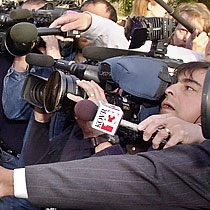With a third royal commission pending, and ABC chaos, plus a series of company crises (Dreamworld, Big Un, Get Swift, CPA) media and public tolerance for rotten corporate culture has all but vanished.
Culture is the one way we can unite our organisation behind our business goals and behaviours. It’s sometimes our only competitive advantage. It’s why staff and customers will stay, or leave. A rotten culture definitely holds a company back; a positive culture drives you forward.
Culture starts with as a concept for a leader, and ends as the conversation in inside every employee’s head.
Even for excellent companies this is relevant because all companies are undergoing forced and constant change.
The Culture Creator
Someone has to lead, a person who puts aside blocks of thinking time, because nurturing a culture requires constant reflection and adjustment.
In the TV journalism units where I worked for over 30 years, it was a strong person in the corner office directing traffic, debates, story topics, ethics, tempo, and the program’s opinions.
If the leader is driven, that will be the culture; same if he/she is cheerful, creative, process-oriented, glass-half-full or empty, an innovator, into repetition, empathetic, inflexible, happy or sad.
For a CEO, creating the ultimate culture is one of the toughest gigs, and for each it’s different. I meet with a group of CEOs every month and we argue issues so we can be better. Culture comes up in almost everything: productivity issues, change management, driving growth, training, problems with millennials (now Gen Z), increasing profit, how to hire and fire, and more.
Even defining a culture suitable for an organisation is complex; there are so many differing opinions. But for me it’s a combination of: People (shared values and behaviours), Vision, Ambition, Systems and Processes.
The Right People
Like-minded people, with similar values and behaviours, create a strong culture. Jim Collins’ thesis in his ‘Good to Great’ book in 2001 and his belief in ‘getting the right people on the bus’, changed a lot of employment tactics.
In a small office, and probably all leaderships teams, one misaligned person can drag the rest down. Hence, the ‘hire slow, fire fast’ philosophy.
As a colleague of mine remarked, “We need robust debate, but not sand in the gears.”
Vision
If the leader can’t express “Where we are going”, nor can anyone else. Certainly in my careers in journalism and then in corporate affairs, people want both meaning in their work and a strong sense of direction.
In this era of constant change this is increasingly important. Where change is a necessity, people want not only a clear idea of where they are going, but need a clear “Why” they are being removed from the comfort of their current work (“He who has a why to live,” philosopher Friedrich Nietzsche famously wrote, “can bear almost any how.”).
Ambition
This is the collective organisation’s (not personal) ambition. It can be high or low; maybe it doesn’t matter. However, in journalism and corporate affairs, which require high levels of excellence, creativity and nimbleness, it must be high.
An ambitious company will naturally attract ambitious people and managing ambition is a big issue in a small business, because in a flat hierarchy there’s not a lot of room for promotion. The only real solutions I’ve found so far are to keep changing the company by growing, varied and interesting work, and creating a ‘constant learning’ culture.
Systems & Processes
Systems are easy in a digital age, so people rightly expect efficiency; from computers to invoicing, everything must seamlessly work.
Processes are more dynamic. How many meetings and what are their purposes and outcomes? Do we start at 8:30am or on flexy-times? Must we work in the office, or is remote work and option? Do we socialise or not? All these are rightly constant internal debates.
Top-down/bottom-up?
There’s a conversation to be had in small companies about whether culture is best created by staff or by the leaders. In my view both. A weak or directionless leader is hardly going to inspire downwards. However, a culture in which creative ideas aren’t channelled up is equally depressing.
Diversity is being driven from the bottom. So are the #MeToo issues and environmental awareness.
But in the initial stages of culture development, or culture change, starts at the top. The leaders create the climate for the interactions to flow.
At A Current Affair in the early ‘90s, one of my bosses used to make it clear to me he wanted the program to be part of the national debate, and it was measurable, “I want to be on the front page of the papers, leading debate, at least once a month!” And for a number of years we were.
Colleagues in my former and current work have always expected forthright, positive conversations (there is a great book, Fierce Conversations, by Susan Scott, that explores how strong and honest conversations can occur). The desired internal behaviours we discuss here continually includes ‘Strong & Honest Relationships (along with Excellence, Creativity, and Nimbleness).





